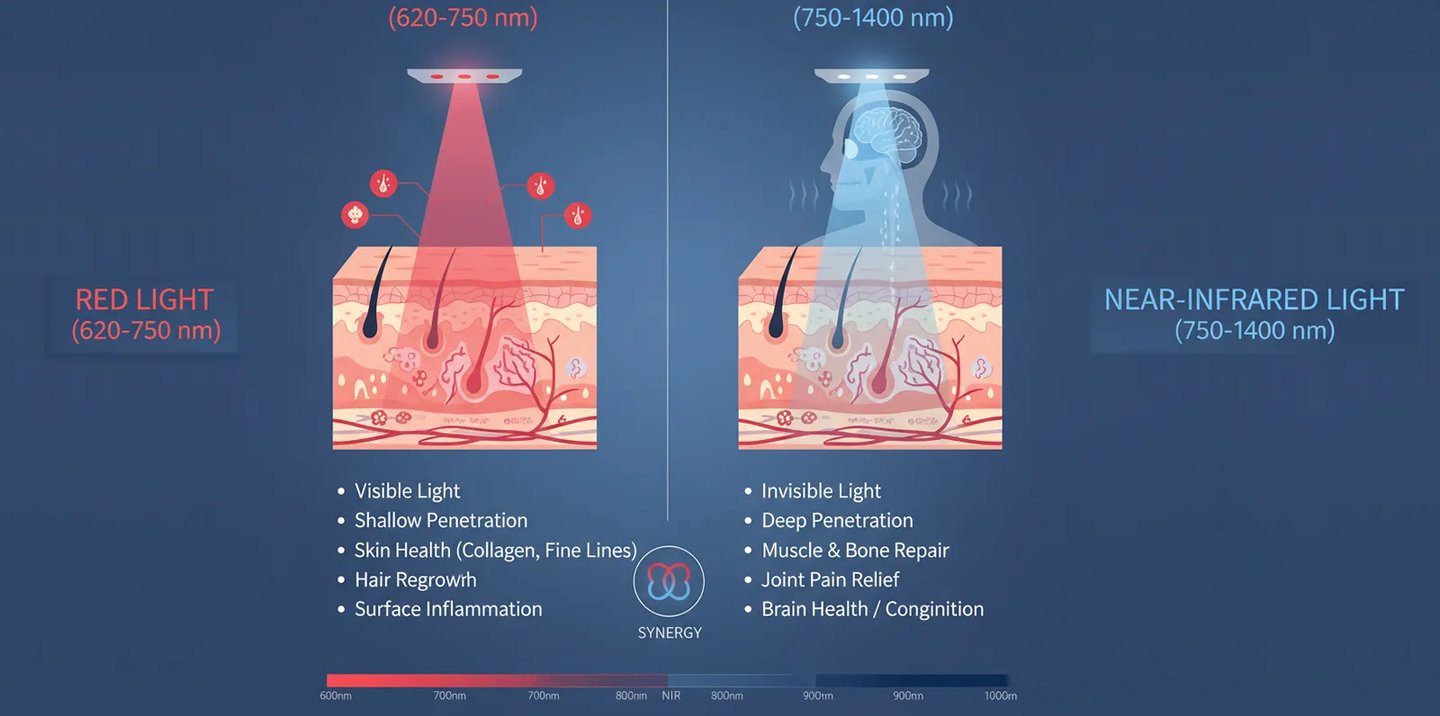Red Light vs. Near-Infrared Light: Understanding Their Distinct Health Benefits
This article explores the fundamental differences between red light and near-infrared light, focusing on their distinct wavelengths, penetration depths, and specific biological effects. It highlights how red light primarily benefits superficial skin issues, while near-infrared light excels in deep tissue repair, pain management, and potential brain health improvements, ultimately emphasizing their unique applications and synergistic potential in health and wellness.
YEEQO
9/15/20253 min read


Red Light Therapy vs. Near-Infrared Light Therapy: Unveiling Distinct Health Benefits & Applications
Within the vast expanse of the electromagnetic spectrum, light plays a crucial role in biological processes. While daily visible light is just a small fraction, beyond it lie specialized wavelengths – red light and near-infrared light – that profoundly impact human health. Though often grouped together in discussions, red light and near-infrared light possess distinct differences in wavelength, penetration depth, and biological effects. Understanding these critical distinctions is key to effectively leveraging their therapeutic potential in health and wellness.
1. Wavelength & Visibility: The Core Distinction
The most fundamental difference between these two therapeutic lights lies in their wavelength ranges, directly impacting their visibility to the human eye.
Red Light (RLT): This segment of the visible spectrum typically spans from 620 nm to 750 nm. Being at the longer-wavelength end of visible light, red light is clearly perceptible to us, often seen in various therapeutic devices.
Near-Infrared Light (NIR): Situated just beyond red light, NIR belongs to the invisible spectrum, with wavelengths generally ranging from 750 nm to 1400 nm. Due to its longer wavelength, near-infrared light is imperceptible to the human eye, yet its effects are powerful.
2. Penetration Depth: A Key to Therapeutic Reach
Wavelength is a pivotal factor in determining light's ability to penetrate human tissue. Longer wavelengths encounter less scattering and absorption, allowing for deeper tissue penetration.
Red Light Penetration: Due to its comparatively shorter wavelength, red light's penetration depth is relatively limited. It primarily targets the superficial layers of the skin, including the epidermis and dermis. This makes it highly effective for influencing hair follicles, sebaceous glands, and shallow vascular structures.
Near-Infrared Light Penetration: Leveraging its significantly longer wavelength, near-infrared light achieves deeper penetration into bodily tissues. It can traverse the skin and subcutaneous layers, reaching muscles, bones, and even the brain. This profound penetrative capability grants NIR unique advantages in treating deep tissue damage and promoting comprehensive systemic health benefits.
3. Biological Effects & Applications: Targeted Wellness
Both red light and near-infrared light stimulate cellular activity, but their specific biological effects and applications diverge based on their distinct penetration depths.
Red Light Benefits & Applications:
Skin Health & Anti-Aging: Frequently utilized to improve skin conditions, red light therapy promotes collagen production, reduces fine lines and wrinkles, accelerates wound healing, and alleviates inflammation and acne.
Hair Regrowth Stimulation: It exerts a stimulating effect on hair follicles, making it a valuable tool for addressing hair loss issues.
Surface Inflammation Relief: Effective in reducing superficial inflammation and pain on the skin.
Common Applications: Widely found in beauty devices, dermatological treatment equipment, and at-home light therapy systems.
Near-Infrared Light Benefits & Applications:
Deep Tissue Repair: Its ability to reach muscles and bones makes NIR therapy highly effective for athletic injury recovery, arthritic pain relief, and bone fracture healing.
Chronic Pain Management: Demonstrates significant efficacy in alleviating various forms of chronic pain, including muscular, neuropathic, and joint discomfort.
Brain Health Enhancement: Emerging research suggests near-infrared light therapy may positively impact brain function, potentially improving cognitive abilities, mitigating symptoms of depression and anxiety, and showing promise for neurodegenerative conditions.
Systemic Wellness: By enhancing blood circulation and cellular metabolism, NIR positively influences overall energy levels and general well-being.
Common Applications: Utilized in advanced medical treatment devices, high-power light therapy units, rehabilitation equipment for muscles and joints, and brain phototherapy systems.
4. Synergistic Effects: The Power of Combination Therapy
It's important to recognize that red light and near-infrared light are not mutually exclusive. In many modern light therapy devices often combine both wavelengths to harness their synergistic effects. Red light effectively addresses superficial skin and shallow tissue concerns, while near-infrared light provides deeper therapeutic action. This combined approach often leads to more comprehensive and potent therapeutic outcomes.
While both red light and near-infrared light are invaluable components of the electromagnetic spectrum beneficial to biological organisms, they possess clear distinctions in their wavelengths, penetration depths, and primary biological effects. Red light excels at addressing superficial skin issues, whereas near-infrared light, with its superior penetrative capability, plays an indispensable role in the health of deep tissues such as muscles, bones, and the brain. Understanding and judiciously utilizing the unique advantages of both red light therapy and near-infrared light therapy will undoubtedly pave broader avenues for advancements in health maintenance and disease treatment.
